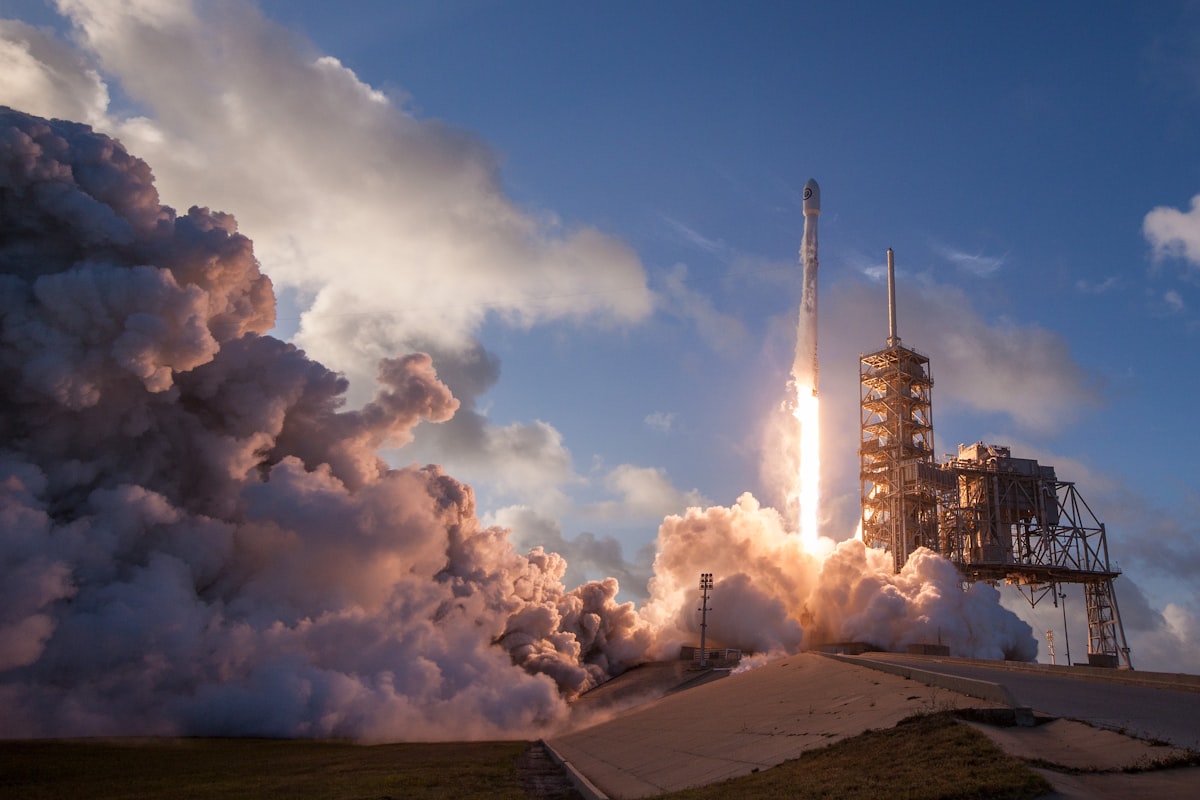
SpaceX Starship: First Mars Mission in 2026, Humans by 2028 (Maybe)
Jean Louis
Elon Musk reveals ambitious SpaceX Starship timeline: uncrewed Mars mission in 2026, humans landing by 2028. Explore the latest Starship V3 developments, successful test flights, and the 50/50 odds of making history in the race to Mars.
SpaceX Starship: First Mars Mission in 2026, Humans by 2028 (Maybe)
Elon Musk has done it again—announced an ambitious timeline that has space enthusiasts buzzing and skeptics raising eyebrows. SpaceX plans to send its first uncrewed Starship to Mars in 2026, with humans potentially landing on the Red Planet by 2028.
But there's a catch: Musk himself admits it's a "50/50 chance" of hitting these targets.
Let's break down what's happening with the world's most powerful rocket and whether we're really about to become an interplanetary species.
The United Nations has designated 2025 as the International Year of Quantum Science and Technology, highlighting the growing importance of breakthrough technologies including space exploration.
2025: The Year Starship Came Back
After a rocky start with explosive setbacks, SpaceX made a triumphant comeback in August 2025 with Starship's 10th test flight—and this one actually worked.
August 2025 Test Flight Success
The latest launch marked several historic firsts:
✅ First Successful Payload Deployment
- Deployed 8 mock Starlink satellites
- Demonstrated cargo bay functionality
- Proved orbital delivery capabilities
✅ Engine Relight in Orbit
- Successfully relit Raptor engine in space
- Critical for returning from Mars
- Proved deep space maneuver capability
✅ Heat Shield Stress Test
- Intentionally tested thermal protection system limits
- Gathered data for Mars re-entry planning
- Shield performed better than expected
These achievements aren't just checkboxes—they're the fundamental capabilities needed for Mars missions. Every successful test brings the dream of interplanetary travel closer to reality.
The Explosive Journey to Success
SpaceX's path to the successful August test was… fiery, to put it mildly.
2025 Setbacks
January Test Flight: Mid-flight explosion
- Upper stage failed during ascent
- Debris scattered over Gulf of Mexico
- Grounded for safety review
March Test Flight: Another mid-flight explosion
- New failure mode discovered
- Additional modifications required
- Launch license suspended
May Test Flight: Third explosion
- Different failure point than previous tests
- SpaceX described as "rapid unscheduled disassembly"
- Growing concerns about timeline
June Static Fire Test: Exploded on launchpad
- Most expensive setback
- Significant launchpad damage
- Required extensive repairs
Why These Failures Actually Matter
"If you're not failing, you're not innovating hard enough." Each explosion provided invaluable data that traditional slow-and-careful approaches would take years to gather.
SpaceX's test-to-failure approach is fundamentally different from NASA's traditional methodology:
Before
After
Meet Starship Version 3: Bigger, Better, (Hopefully) More Reliable
Following the August success, Musk announced that Starship Version 3 will launch by the end of 2025, featuring significant upgrades.
V3 Specifications
Engine Configuration:
- 33 Raptor engines → 42 Raptor engines
- 27% increase in thrust
- Improved redundancy
- Better control authority
Full Reusability:
- Both stages designed for complete reuse
- No expendable components
- Rapid turnaround capability
- Economic viability for Mars missions
Enhanced Payload Capacity:
- 150+ tons to low Earth orbit
- 100+ tons to Mars (estimated)
- Largest payload capacity of any rocket in history
Improved Systems:
- Advanced heat shield materials
- Upgraded avionics
- Better propellant management
- Enhanced landing capabilities
Step 1: Booster Launch and Separation
Super Heavy booster with 42 Raptor engines ignites, lifting the entire stack. At 70km altitude, the booster separates and begins its return to Earth.
Step 2: Orbital Insertion
Ship continues to orbit using its 6 Raptor engines. Payload bay doors open for satellite deployment or cargo operations.
Step 3: Booster Recovery
Super Heavy booster performs propulsive landing back at the launch tower, caught by mechanical arms ("Mechazilla") for rapid reuse.
Step 4: Mars Transfer (Future Missions)
For Mars missions, the ship will wait in orbit for orbital refueling before executing trans-Mars injection burn.
The Mars Timeline: 2026-2028
Here's Musk's current plan for making humanity a multiplanetary species:
2026: First Uncrewed Mission
Objectives:
- Demonstrate Earth-Mars transit capability
- Test entry, descent, and landing (EDL) on Mars
- Deploy initial cargo and infrastructure
- Validate life support systems
- Establish propellant production facility
Challenges:
- 6-9 month journey to Mars
- Autonomous landing on unprepared terrain
- Long-duration deep space operation
- Radiation exposure management
Likelihood: Musk estimates 50/50 chance
Why the uncertainty?
Orbital Refueling: SpaceX still needs to prove they can transfer hundreds of tons of propellant between ships in orbit. This has never been done at the required scale and is absolutely critical for Mars missions.
2028: First Crewed Mission
If 2026 succeeds, humans could land on Mars by 2028:
Crew Size: 12-20 astronauts (estimated)
Mission Duration:
- 6-9 months outbound journey
- 500-day Mars surface stay
- 6-9 months return journey
- Total: ~2.5-3 years
Key Challenges:
- Radiation Exposure: Mars lacks magnetic field protection
- Psychological Factors: Isolation for 3 years
- Medical Emergencies: No hospitals on Mars
- Food Production: Hydroponics and stored supplies
- Return Fuel: Must be manufactured on Mars
Getting to Mars requires refilling Starship's tanks in orbit with multiple tanker flights. SpaceX estimates 8-12 refueling missions per Mars ship. This complex orbital ballet has never been attempted and represents the biggest technical hurdle.
Why Mars? The Case for Red Planet Colonization
Musk's Mars obsession isn't just ego—there are legitimate reasons for establishing a human presence on Mars.
Scientific Reasons
1. Searching for Life
- Evidence of ancient water on Mars
- Potential for microbial life underground
- Understanding planetary evolution
2. Planetary Protection
- Humanity's "backup drive"
- Extinction-level event insurance
- Species survival strategy
3. Resource Utilization
- Water ice at poles
- Regolith for construction
- In-situ propellant production
Economic Potential
Long-term Opportunities:
- Mining rare materials
- Tourism (eventually)
- Scientific research stations
- Technological innovation spillover
Challenges to Profitability:
- Enormous upfront costs ($100B+ estimates)
- No clear return on investment timeline
- Requires sustained multi-generational commitment
The Competition: Who Else is Racing to Mars?
SpaceX isn't alone in eyeing the Red Planet.
NASA's Artemis and Mars Plans
Timeline: Humans on Mars by mid-2030s
Approach:
- Moon first (Artemis program)
- Establish lunar gateway
- Test technologies on the Moon
- Then attempt Mars
Advantages:
- Government funding stability
- Decades of experience
- International partnerships
Disadvantages:
- Slower, more cautious approach
- Higher costs per mission
- Bureaucratic constraints
China's Mars Ambitions
Timeline: Crewed Mars mission by 2033
Recent Achievements:
- Successful Tianwen-1 Mars orbiter and rover (2021)
- Building space station experience
- Developing heavy-lift rockets
Watch Factor: China's stated goals have historically underestimated their actual pace.
Blue Origin and Others
- Blue Origin: Focused on lunar missions currently
- European Space Agency: Robotic missions, no crewed plans
- India (ISRO): Successfully landed on Moon, Mars next?
Unlike the 1960s Moon race between the US and USSR, today's space competition involves private companies, multiple nations, and collaborative international efforts. The winner might be humanity itself.
Technical Challenges Still to Solve
Despite impressive progress, significant obstacles remain:
1. Orbital Refueling at Scale
The Problem:
- Must transfer 1,200 tons of propellant in orbit
- Requires 8-12 tanker flights per Mars mission
- Never been demonstrated
- Cryogenic fuel management in microgravity
Current Status: Ground tests ongoing, no orbital demonstration yet
2. Mars Entry, Descent, and Landing (EDL)
The Challenge:
- Mars atmosphere is 1% of Earth's
- Too thin for parachutes alone
- Too thick to ignore
- Must slow from 20,000 mph to 0 mph
Solution: Propulsive landing with massive fuel reserves
3. Radiation Protection
The Threat:
- Cosmic radiation during 6-9 month journey
- Solar particle events
- Long-term health impacts
Potential Solutions:
- Water-lined walls (dual-purpose radiation shield/storage)
- Storm shelters for solar events
- Faster transit times (nuclear propulsion long-term)
4. Life Support for 3 Years
Requirements:
- Reliable oxygen generation
- Water recycling (99.9%+ efficiency)
- Food production/storage
- Waste management
- Psychological well-being
ISS Lessons: Current ISS can support 7 crew for 6 months; Mars needs 20 crew for 3 years.
5. Return Fuel Production on Mars
The Plan: Make methane and oxygen from Mars' CO2 atmosphere
Status:
- Demonstrated in lab conditions
- Never tested on Mars
- Requires substantial power (solar arrays or nuclear)
- Must be autonomous and reliable
What Success Would Mean for Humanity
If SpaceX pulls this off—landing humans on Mars in 2028—the implications are staggering.
Technological Spillovers
Technologies developed for Mars will benefit Earth:
- Advanced life support systems
- Closed-loop recycling
- Radiation shielding
- Autonomous systems
- Energy generation and storage
- Food production innovations
Economic Impact
Space Industry Growth:
- $1+ trillion space economy by 2040
- Thousands of high-tech jobs
- Supply chain development
- New industries and opportunities
Philosophical Shifts
Becoming a two-planet species changes how we view ourselves:
- Perspective on Earth's fragility
- United human identity
- Long-term thinking (decades to centuries)
- Renewed inspiration for STEM fields
The Skeptics' View: Why 2028 Might Not Happen
Let's be realistic—Musk's timelines are notoriously optimistic.
Historical Track Record
Tesla Roadster (2008)
- Promised: 2006
- Delivered: 2008
- Delay: 2 years
Model 3 Production Ramp (2017)
- Promised: 5,000/week by end 2017
- Achieved: July 2018
- Delay: 7 months
Full Self-Driving (Still Waiting)
- Promised: "Next year" since 2016
- Status in 2025: Still Level 2, requires driver attention
Starship Orbital Flight
- Promised: 2019
- Achieved: 2023 (partial), 2025 (successful)
- Delay: 4-6 years
Will Humans Land on Mars by 2028?
Pros
- SpaceX has proven ability to iterate rapidly
- Successful August 2025 test flight shows progress
- Starship V3 addresses known issues
- Musk's companies eventually deliver (with delays)
- Strong financial backing and political support
- Reusability dramatically reduces costs
- No technical laws of physics preventing it
Cons
- Orbital refueling never demonstrated
- Mars EDL at this scale untested
- Life support for 3 years unproven
- Return fuel production on Mars theoretical
- Radiation protection inadequate
- Musk timelines historically off by 2-5 years
- Single Starship loss could delay years
Realistic Timeline?
Conservative Estimate: 2032-2035 for first crewed Mars landing
Optimistic Estimate: 2029-2030 if everything goes perfectly
Musk Estimate: 2028 (with 50/50 odds)
FAQ: SpaceX Starship and Mars Missions
Musk switched to stainless steel because it's cheaper, easier to work with, and performs better at the extreme cold temperatures of cryogenic propellants and the extreme heat of atmospheric reentry. Steel actually gets stronger at cryogenic temperatures, while carbon fiber becomes brittle.
Musk has stated a goal of under $500,000 per person, eventually dropping to $100,000-200,000 as the system matures. However, early missions will likely cost significantly more, possibly $1M+. These estimates assume full reusability and high flight rates (100+ Starships per Mars window).
Starship is designed for round-trip missions. The ship will manufacture return fuel on Mars using the Sabatier process, combining Mars' CO2 atmosphere with water ice to produce methane and oxygen. This is critical for the mission architecture—Musk has explicitly ruled out one-way suicide missions.
Radiation is a major concern. The 6-9 month journey exposes crew to significant cosmic radiation and solar particle events. Current plans include water-lined walls for radiation shielding, storm shelters for solar events, and possibly faster transit times in the future. Long-term health effects remain unknown and represent a major risk for early Mars pioneers.
A Starship filled with propellant on Earth is too heavy to reach orbit. It must launch partially full, then be refueled in orbit by 8-12 tanker flights before heading to Mars. This requires transferring 1,200 tons of cryogenic propellant in microgravity—never done before. Without solving this, Mars missions are impossible with current technology.
That's the terrifying reality. There's no hospital, no rescue mission, and Earth is 6-9 months away. Early Mars missions will need redundant systems, comprehensive medical capabilities, and crew members cross-trained in multiple disciplines. Some emergencies simply won't be survivable. This is why Musk talks about early Mars settlers being willing to accept significant risk.
Conclusion: The 50/50 Bet on History
Elon Musk's 2026 uncrewed and 2028 crewed Mars timelines are ambitious, bordering on outlandish. But that's the point.
SpaceX has a track record of:
- ✅ Achieving the "impossible" (reusable rockets)
- ✅ Disrupting industries (commercial spaceflight)
- ✅ Learning from spectacular failures
- ✅ Eventually delivering (with delays)
But they still need to:
- ⚠️ Demonstrate orbital refueling
- ⚠️ Prove Mars EDL at scale
- ⚠️ Solve radiation protection
- ⚠️ Validate life support for years
- ⚠️ Make return fuel on Mars
- ⚠️ Launch Starship V3 successfully
The Verdict:
Will humans land on Mars by 2028? Probably not.
Will humans land on Mars in the early 2030s? Very likely.
Will SpaceX be the ones to do it? Almost certainly.
Musk's timelines may be optimistic, but his vision has consistently driven the industry forward. When he promised reusable rockets, experts laughed. When he said Tesla would make electric cars cool, skeptics doubted. When he claimed SpaceX would land humans on Mars, people called it fantasy.
Yet here we are in 2025 with successful Starship orbital flights, Tesla dominating the EV market, and Mars missions transitioning from science fiction to engineering problem-solving.
Whether it's 2028, 2032, or 2035, humanity is going to Mars. And when we do, it will fundamentally change our species' trajectory. We'll look back at this decade as the moment we took our first real steps toward becoming a spacefaring civilization.
The countdown to Mars has begun. History is watching.
Want to follow SpaceX's progress? Check out our guides on Starship technology, the economics of space travel, and what life on Mars might actually look like for early settlers.
Related Articles

OpenAI AWS Partnership Explained: The $38B Deal That's Reshaping AI
OpenAI just signed a $38B deal with AWS, breaking Microsoft's AI monopoly. Here's what this means for ChatGPT, the AI industry, and you.

ChatGPT vs Claude vs Gemini: The Ultimate 2025 AI Showdown
Complete comparison of ChatGPT, Claude, and Gemini in 2025. Discover which AI is best for coding (Claude 4), research accuracy (ChatGPT leads at 60%), multimodal tasks (Gemini 2.5), pricing, features, and real-world use cases. Plus: Claude has 400M users, while ChatGPT introduced killer Memory feature.

Tesla Model Y Breaks Sales Records While Cybertruck Struggles: The EV Market in 2025
Tesla Model Y achieves record-breaking 114,897 units sold, becoming the best-selling EV in the U.S., while Cybertruck faces a 63% sales decline. Explore lease pricing changes, upcoming features like V2L technology, and what this means for the electric vehicle market in 2025.
Written by
Jean Louis
Tech enthusiast and professional developer sharing insights on modern web development.
Comments (0)
Join the discussion and share your thoughts
You must be logged in to post a comment.
Sign In to CommentNo comments yet. Be the first to share your thoughts!